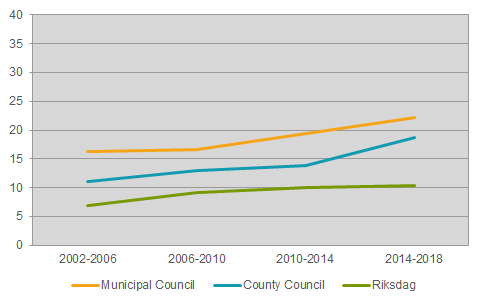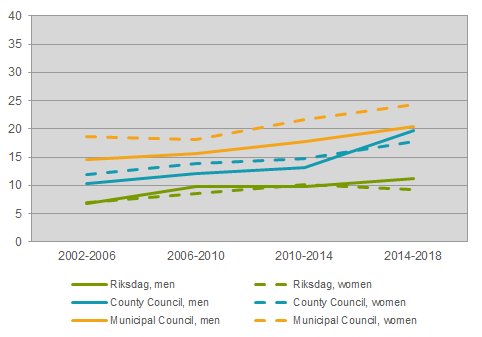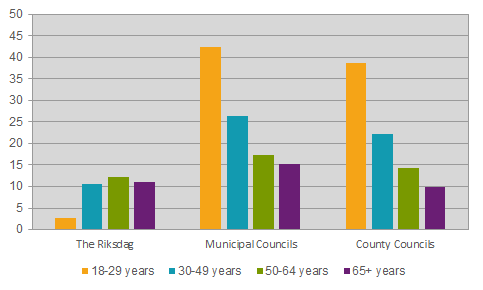General elections, nominated and elected candidates, 2014-2018
More than one out of five elected representatives resigned from the municipal council
Statistical news from Statistics Sweden 2019-01-16 9.30
Resignations from elected councils continued to increase during the previous electoral period. The largest increase was in the county councils. The increase in the number of resignations is greater among men than among women. The largest numbers of resignations are among young elected representatives in the municipal and county councils.
Statistics Sweden is now publishing statistics on resignations among elected representatives during the previous electoral period (2014-2018). The percentage of resignations was the greatest recorded among the four electoral periods that Statistics Sweden has studied this matter. Resignation was most common among elected representatives in municipal councils, where 22 percent resigned their positions in the council before the end of the electoral period. However, compared with the previous electoral period, resignations increase most among representatives in the county councils. Here, the percentage of resignations was 19 percent, an increase of nearly 5 percentage points. The percentage of resignations increased, in particular, in municipal and county councils. On the other hand, the increase in resignations among members of the Riksdag was marginal; just as in the previous electoral period, 10 percent resigned during the electoral period.

Resignations increased more among men
For the first time, the percentage of resignations among elected representatives to county councils was greater among men than among women. Among elected members of the Riksdag, there were also more resignations among men than among women. Among women elected as members of the Riksdag, resignations decreased slightly compared with resignations in the electoral period 2010-2014. It remains more common among women to resign from municipal councils, but the increased resignations are also greater among men than among women, albeit by a small margin.

Young elected representatives to a greater degree resign from county and municipal councils
There are considerable differences between various age groups with regard to resignations from elected councils. Among young people (18-29 years) elected to county and municipal councils, it is more common to resign than among older people. Among young people elected to county and municipal councils, roughly four out of ten resigned before the end of the electoral period. In the Riksdag, differences between age groups are smaller and, on the contrary, the percentage of resignations is lower among young elected representatives than among older representatives. The percentage of resignations was higher throughout among young women than among young men.

Definitions and explanations
The Riksdag, the counties and the municipalities report information on an ongoing basis to the Election Authority concerning candidates who choose to leave their positions during the electoral period. Annually and after a completed electoral period, Statistics Sweden then produces information on elected candidates who have resigned during the electoral period. Statistics Sweden's presentation on resignations only includes information on candidates who were originally elected and, therefore, not information on resignations among replacement members, which is included in the Election Authority's report.
Our elected councils vary in size, which means that a single resignation will have varying significance on the proportion of resignations. In the 2014 election, 349 candidates were elected to the Riksdag, 1 678 candidates were elected to the 20 county councils in Sweden, and 12 763 candidates were elected to the 290 municipal councils.
Statistical Database
More information is available in the Statistical Database
Feel free to use the facts from this statistical news but remember to state Source: Statistics Sweden.
